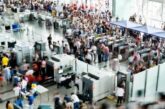
IATA :Passenger Growth Slowed in August
aTP- Arab tourism portal News- (Geneva) – The International Air Transport Association (IATA) announced global passenger traffic data for August showing that demand (measured in total revenue passenger kilometers or RPKs) climbed 4.6% compared to the year-ago period. This represented a slowing from the 6.4% increase recorded in July (revised). August capacity (available seat kilometers or ASKs) increased by 5.8%, and load factor slipped 0.9 percentage points to 83.8%%.
.jpg) “Growth in passenger demand dipped to 4.6%. While that’s disappointing compared to the previous month’s performance, it is still healthy growth. And although terrorist attacks in Europe have dampened demand, the impact is ebbing,” said Alexandre de Juniac, IATA’s Director General and CEO.
“Growth in passenger demand dipped to 4.6%. While that’s disappointing compared to the previous month’s performance, it is still healthy growth. And although terrorist attacks in Europe have dampened demand, the impact is ebbing,” said Alexandre de Juniac, IATA’s Director General and CEO.
International Passenger Markets
August international passenger demand rose 4.7% compared to August 2015. All regions recorded increases, but growth was dominated by airlines in the Middle East. Capacity climbed 6.5%, causing load factor to slide 1.4 percentage points to 83.9%.
Asia-Pacific airlines’ August traffic climbed 5.6% compared to the year-ago period. Capacity rose 6.8% and load factor slipped down 0.9 percentage points to 81.9%. There are signs of Asian travelers continuing to be put-off by recent terrorism in Europe. Traffic on Europe-Asia routes grew just 1.5% in July, the most recent month for which route-specific figures are available, while international traffic growth on routes within Asia accelerated to 9.9%.
European carriers saw August demand climb 3.3% year-on-year. European traffic continues to be affected by the impact of terrorism, however, there are indications this may be easing. Capacity rose 5.1%, which caused load factor to drop 1.6 percentage points to 86.6%–which still was the highest among regions.
Middle Eastern carriers posted a 10.3% traffic increase in August, while capacity climbed 13.7%, resulting in a 2.5 percentage point fall in load factor to 81.2%.
North American airlines’ international demand rose 1.8% compared to August a year ago. However, seasonally-adjusted traffic has risen at an annualized rate of 7% since March, supported by transpacific demand and leisure routes to Central America and the Caribbean. Capacity rose 3.8%, causing load factor to drop 1.7 percentage points to 85.3%.
Latin American airlines experienced a 6.7% demand rise compared to the same month last year, helped by strong demand on international routes within the region, spurred in part by the 2016 Summer Olympics in Brazil. Capacity increased by 4.0% and load factor rose 2.1 percentage points to 84.0%. Carriers in this region were the only ones to see a rise in load factor compared to the year-ago period.
African airlines’ traffic climbed 1.8% in August. International growth has tracked sideways since the start of the year, reflecting challenges in the major economies. Capacity rose 3.1%, with the result that load factor slipped 1.0 percentage point to 75.6%, lowest among regions.
Domestic Passenger Markets
Demand for domestic travel climbed 4.3% in August compared to August 2015, which was slightly exceeded by a 4.4% increase in capacity. Load factor slid 0.1 percentage points to 83.6%. All markets reported demand increases with the exception of Brazil and Russia, with India and China reporting double-digit rises.
Russia’s domestic traffic fell 2.7% but the failure of Transaero last year has taken significant capacity out of the market, and load factor reached a record high for the month at 86.5%. It was also the highest among the domestic markets tracked by IATA.
US airlines’ domestic traffic climbed just 1% year-on-year in August and traffic has trended sideways in seasonally-adjusted terms since late 2015.
The Bottom Line: “Lower airfares are a major factor sustaining demand for air travel. And airline profitability is stronger than ever as a result of a better industry structure and efficiency gains. But the lingering impact of terrorist attacks in Europe earlier in the year reminds us that the aviation industry is vulnerable to many external factors beyond its control.
The risks—including the normal ups and downs of the business cycle—won’t go away. The industry has improved resilience along with its profitability. That will be critical to responding quickly should the business environment change,” said de Juniac.







